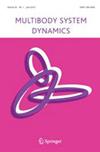时空刚体多体动力学
IF 2.4
2区 工程技术
Q2 MECHANICS
引用次数: 0
摘要
在这篇论文中,我们将时空公式应用于约束刚体动力学。特别地,我们使用适当的时空逼近空间对变分问题直接离散哈密顿原理。此外,我们利用刚体的无旋转公式,因此我们也必须为拉格朗日乘子定义适当的近似空间。此外,我们利用Livens原理,为位置、速度和动量引入独立的量,其中后者可以被认为是拉格朗日乘子,我们将这个概念应用于时空刚体公式。最后,我们展示了不同方法的收敛性和计算量方面的优势,从而证明了动态仿真的总能耗。本文章由计算机程序翻译,如有差异,请以英文原文为准。

Space-time rigid multibody dynamics
Abstract In this contribution, we apply space-time formulation on constrained rigid body dynamics. In particular, we discretize directly Hamilton’s principle using appropriate space-time approximation spaces for the variational problem. Moreover, we make use of a rotationless formulation for the rigid bodies, and thus we have to define appropriate approximation spaces for the Lagrange multipliers as well. Moreover, we make use of Livens’ principle, introducing independent quantities for the position, velocity, and momentum, where the latter can be considered as Lagrange multipliers, and we apply this concept to the space-time rigid body formulation. Finally, we demonstrate the convergence of the different approaches and the superiority in terms of computational effort, and thus total energy consumption of dynamical simulations.
求助全文
通过发布文献求助,成功后即可免费获取论文全文。
去求助
来源期刊
CiteScore
6.00
自引率
17.60%
发文量
46
审稿时长
12 months
期刊介绍:
The journal Multibody System Dynamics treats theoretical and computational methods in rigid and flexible multibody systems, their application, and the experimental procedures used to validate the theoretical foundations.
The research reported addresses computational and experimental aspects and their application to classical and emerging fields in science and technology. Both development and application aspects of multibody dynamics are relevant, in particular in the fields of control, optimization, real-time simulation, parallel computation, workspace and path planning, reliability, and durability. The journal also publishes articles covering application fields such as vehicle dynamics, aerospace technology, robotics and mechatronics, machine dynamics, crashworthiness, biomechanics, artificial intelligence, and system identification if they involve or contribute to the field of Multibody System Dynamics.

 求助内容:
求助内容: 应助结果提醒方式:
应助结果提醒方式:


